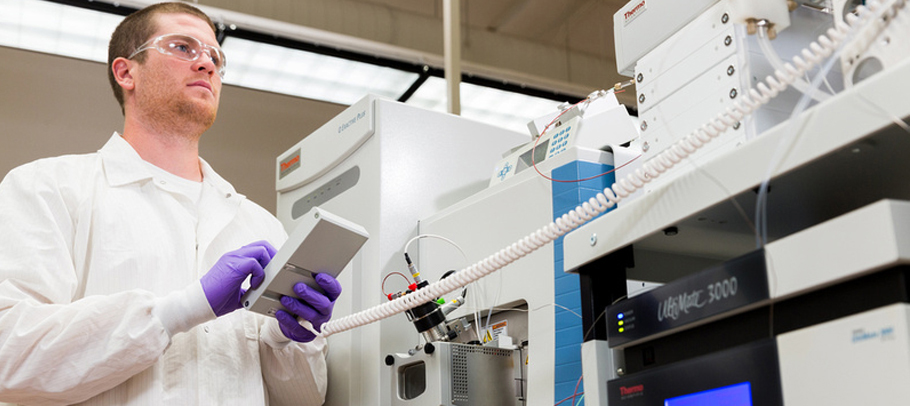
Why Use Liquid Chromatography-Mass Spectrometry in Drug Discovery and Development?

In the article below, Jie Ding, director of mass spectrometry and protein characterization at PPD® Laboratories, discusses liquid chromatography-mass spectrometry (LC-MS) in drug discovery and development.
In a drug stability program, high-performance liquid chromatography (HPLC) with ultraviolet (UV) detection remains the most common and cost-effective methodology. Even so, UV detection has its own limitations, including poor sensitivity for non-UV absorbing compounds and lack of specificity. These shortcomings in turn have motivated scientists to pursue other alternatives. Mass spectrometry detection is such a candidate. Mass spectrometry (MS) is a detection method that measures the mass-to-charge ratio (m/z) of a compound. Compared to UV detection, MS offers higher sensitivity, better detection limits, and the ability to provide additional molecular weight information—making it an “information rich” detection method.
Over the last two decades, MS has become an important analytical tool to support drug discovery and development in both quantitative and qualitative analyses. For instance, MS can be coupled with liquid chromatography to isolate and measure analytes of interest. Modern LC-MS instruments are relatively easy to operate and maintain. However, pitfalls are not unexpected, especially for accurate measurement of analyte(s) at trace concentrations or in complex samples. These often can be caused by the apparent ease with which the technique can be applied to increasingly demanding applications, and the tendency of manufacturers to over emphasize the benefits of their products with a workflow-driven software package. Combinations of good instrumentation and experienced analysts are still critical for the successful development and implementation of an LC-MS or LC-MS/MS method.
Recently, high-resolution mass spectrometry (HRMS) — such as Time-of-Flight (ToF) or Orbitrap instruments — has gained popularity in structure characterization/elucidation due to its inherent capability to provide high resolving power and accurate mass measurement. A wide range of compounds can be characterized with molecular weights ranging from hundreds to thousands to hundreds of thousands Dalton. HRMS can provide accurate mass measurement to deduce the molecular formulas of an unknown compound. Not only can the accurate molecular weights be determined by HRMS, tandem mass spectrometers (e.g., Ion trap, Q-ToF, etc.) have been routinely used to confirm structures of active pharmaceutical ingredients (API) and/or to elucidate structures of unknowns.
Capabilities are key
At the PPD® Laboratories GMP Lab, we employ more than a dozen-unit resolution mass spectrometers. They are used routinely to support small molecule and oligonucleotide development and stability programs. For instance, we use mass spec to support GMP stability analysis of antisense oligonucleotides (ASO) using ion-pairing (IP) reversed-phase (RP) chromatography coupled with both UV and MS detections, which cover identity, purity and impurity profile analysis of ASO. We also have four Q-ToF and two Orbitrap-based HRMS that can support small molecule impurity identification and large molecule characterization including:
- Accurate molecule weight determination of peptides/proteins/antibody drug conjugates (ADC)
- Peptide mapping
- N-terminal sequencing
- Disulfide bond mapping
- Released N-glycan profiling
- Oligonucleotide sequence confirmation
- Determination of drug-antibody-ratio (DAR) for ADCs
- Identification of post-transitional modifications (PTM)
All of the technology development over the last two decades has enabled MS to be used in more areas than ever before. In the future, hardware development will continue to focus on providing more sensitivity, higher resolution and larger dynamic range. Software development will center on making data collection and deconvolution 21CFR part 11 compliant, as well as incorporating automation for chemical intelligent fragmentation interpretation. Finally, we expect that research in electron transfer dissociation (ETD), top down and bottom-up proteomics, HRMS and software-assisted structural elucidation will have a long-term benefit on biologics analysis.
For additional reading, Jie comments in the article “Mass spectrometry measures up to analytical challenges” in the February 2017 issue of BioPharm International. In addition, she co-authored an article entitled “Development of an efficient LC-MS peptide mapping method using accelerated sample preparation for monoclonal antibodies” in the January 2020 issue of Journal of Chromatography B.